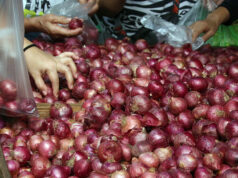Economic team studying typhoon’s budget implications

THE government’s economic team is studying whether this year’s P4.1-trillion budget will need to be augmented to fund the rehabilitation effort after major typhoons hit Luzon.
“We are in the process of evaluating the damage of the series of typhoons and the amounts required to address these, and will determine whether or not the current budget will be sufficient,” Finance Secretary Carlos G. Domiguez III said in a Viber message Monday.
Officials dealing with the economy are currently reassessing the government’s macroeconomic assumptions and fiscal program after gross domestic product contracted by a deeper-than-expected 11.5% in the third quarter, rendering the earlier full-year forecast of a 4.5-6.6% contraction no longer viable.
Crop damage caused by Typhoon Ulysses (international name: Vamco) hit P2.11 billion as of Sunday after it caused widespread flooding in Northern and Central Luzon and parts of Metro Manila.
Ulysses was among five typhoons that struck the Philippines this quarter, causing P38 billion in damage so far.
Damage inflicted on the agriculture sector could push food prices higher, but early harvests may have limited the damage, according to a senior government economist.
“It will (push prices up) but last year, the same thing (Typhoon Ursula, known internationally as Phanfone) happened so we don’t expect the year-on-year level to be significantly different. Besides, the rice harvest is over. The only price impact will be on vegetables,” Finance Undersecretary and the department’s Chief Economist Gil S. Beltran said in a text message Monday.
The impact on inflation will also be minimal as long as the supply of food continues to flow, Socioeconomic Planning Secretary Karl Kendrick T. Chua said in a Viber message.
Inflation rose 2.5% in October from 2.3% in September, driven by higher prices of food and non-alcoholic beverages. This brought the 10-month average to 2.5%, well within the central bank’s target of 2-4%.
In a report, the National Economic and Development Authority (NEDA) said programs for the agriculture sector should also contain measures that will improve its ability to resist and rebound from natural disasters.
“Hence, we underscore the need for increased investment in climate-resilient technologies and infrastructure. While the DA’s (Department of Agriculture’s) Plant, Plant, Plant program and RCEF (Rice Competitiveness Enhancement Fund) aim to boost productivity, disaster resilience may need to be integrated in these measures to improve the agriculture sector’s adaptability to changing weather conditions,” the NEDA said.
More cold storage facilities and warehouses are also needed to extend the shelf life of produce.
It said disaster management systems of the national and local governments should be improved and backed the creation of the Department of Disaster Resilience to improve coordination, monitoring and implementation of programs across various agencies.
“Proposed legislation will provide a clear operational framework to address the fragmented institutional functions and actions among concerned agencies for all possible calamities in the future, including public health emergencies such as pandemics,” it said.
The World Bank estimated that the Philippines sustains typhoon and earthquake damage of P177 billion each year on average to public and private assets. — Beatrice M. Laforga



